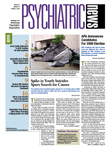APA district branches that previously opposed terms in a Senate-passed mental health parity bill are supporting a compromise measure that addresses a number of their key concerns.
Several district branches (DBs) had contacted APA's Department of Government Relations over the last year to voice opposition to a federal parity bill that passed the Senate in September 2007. The Mental Health Parity Act of 2007 (S 558) would have required insurers to apply the same treatment limitations and cost-sharing requirements to treatment of mental illness, including substance abuse, as they did for other medical services. Similarly, day and visit maximums, copays, and deductibles, would have had to be applied equally.
The Senate bill—arrived at after years of negotiations among Senate parity supporters, business groups, and the insurance industry—drew opposition for language that many psychiatrists in states with strong mental health parity laws said would create a “ceiling,” or national limit, on the maximum parity benefits that insurers could be required to provide.
Some state parity laws go beyond the requirements of the Senate bill or even a stronger House measure (HR 1424), with provisions such as those requiring insurers to allow any licensed mental health or substance abuse treatment provider willing to meet the insurer's terms and conditions into the insurer's network or list of authorized providers.
“Vermont has a broad-based parity bill, which was passed in 1997, with active support from” the Vermont Psychiatric Association (VPA), David Fassler, M.D., VPA's legislative representative and secretary-treasurer of APA, told Psychiatric News. “We were concerned that early drafts of the federal parity bill, specifically the Senate version, contained a preemption clause designed to override such existing state legislation.”
Like several other DBs, the VPA contacted APA and its state congressional delegation to voice its concerns about the Senate bill.
Oregon DB Registers Concerns
John McCulley, executive director of the Oregon Psychiatric Association, said that the DB also had voiced concerns to APA about the Senate bill, because its member psychiatrists were concerned that Oregon's strong parity law, which was enacted in 2005, could be undermined by the federal measure.
“Any time we can provide parity for more people, it will be helpful,” McCulley said.
Many other mental health advocacy groups and state officials also contacted members of Congress to voice their preemption concerns stemming from the Senate bill. For example, Vermont's Department of Banking, Insurance, Securities, and Health Care Administration sent House Speaker Nancy Pelosi (D-Calif.) an analysis that also outlined areas of its state parity law that the Senate bill might override. Advocates for a stronger mental health parity bill called for federal legislation that would establish a base level of mental health parity requirements and allow states to add onto that with their own laws.
The DB opposition to the Senate parity bill was in contrast to other mental health advocates who supported it as the most politically realistic option at this time. Mental health advocates who supported the Senate version were concerned that changes to the carefully negotiated Senate measure, which marked the first time that business and insurance-industry leaders had supported a parity expansion, would keep any parity measure from passing in the current Congress.
Compromise Gains Support
A parity measure that was more popular with mental health advocates and provided only a floor for mental health and substance abuse benefits passed the House of Representatives in March. Congressional negotiators wrestled with differences in the House and Senate versions of parity until a compromise was announced in June. The compromise language dropped the Senate's ceiling on benefits, while retaining other less-controversial components of the Senate bill (Psychiatric News, September 19).
The compromise language has drawn widespread support from previously critical DBs primarily because it allows their stronger state provisions to continue while broadening access to parity coverage, even within those states, by applying to insurance plans that federal law has long barred states from regulating. The federal compromise measure would require equal coverage for both mental and physical health in those plans that provide a mental health benefit, and it would affect coverage of nearly 113 million people. Nearly 82 million of those people affected are insured through plans that fall under the Employee Retirement Income Security Act (ERISA), which are not subject to state parity law requirements. The compromise bill would provide the first expansion in parity requirements for ERISA plans—principally the insurance plans of large, self-insured companies—since a limited federal parity law was enacted in 1996.
“To have comprehensive parity outside of the government [health care insurance] systems, you have to have both state and federal parity,” said Barry Perlman, M.D., chair of APA's Committee on Government Relations and legislative director for the New York State Psychiatric Association, which also had raised concerns about the earlier Senate parity measure. “They really complement each other.”
Fassler said that the compromise bill “represents progress, particularly with respect to ERISA,” although it is not the ideal federal legislation that some parity advocates would like to have. Many parity advocates were hoping for strong federal legislation that would include such measures as requiring all health insurance plans to offer an option with mental health coverage and cover all conditions listed in DSM-IV.
The compromise also “could have a significant impact in Vermont where many larger employers are self-insured and not subject to state insurance regulations,” Fassler noted.
To finally obtain parity for mental health treatment, including that for substance abuse, supporters will need to advocate for the compromise measure's passage in the final weeks of the current Congress. Senate and House supporters are scrambling to find funding offsets for the bill's $3.8 billion, 10-year cost before the compromise can be voted on in both houses.
The text of the parity compromise can be accessed at<http://thomas.loc.gov> by searching on the bill number, S 3334. ▪
